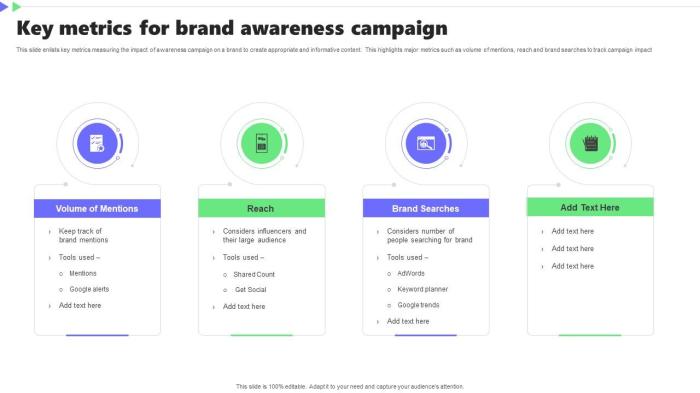Understanding Brand Awareness Metrics dives into the world of crucial business metrics that drive marketing strategies and contribute to overall brand health. Get ready to explore the ins and outs of brand awareness like never before!
In this guide, we’ll break down the importance of brand awareness metrics, discuss different types of metrics, and explore methods for measuring brand recall and monitoring brand recognition. So, buckle up and let’s explore the fascinating world of brand awareness metrics together!
Importance of Brand Awareness Metrics
Brand awareness metrics are like the secret sauce for businesses, yo! They help companies understand how well customers know and recognize their brand in the market. Without these metrics, it’s like trying to navigate a maze blindfolded – you won’t know where you stand or where you need to go.
Brand awareness metrics can totally impact marketing strategies, man. For example, if a company finds out that its brand recognition is low among its target audience, they can focus their marketing efforts on increasing visibility through social media campaigns or influencer partnerships. On the flip side, if the metrics show high brand awareness but low brand perception, they might need to work on improving the quality of their products or services.
When it comes to overall brand health, brand awareness metrics are super important. They give companies insights into how well their brand is performing in the market and help them make informed decisions to strengthen their brand presence. By keeping track of these metrics, businesses can stay ahead of the game and build a strong, long-lasting brand that resonates with customers.
Impact on Marketing Strategies
Brand awareness metrics can totally shake up marketing strategies, dude. Check it – if a company’s metrics show low brand awareness in a certain region, they can tailor their marketing campaigns to target that specific area. By focusing on increasing brand recognition in that region, they can attract more customers and expand their market reach. It’s like hitting the bullseye with every shot, ya know?
- Companies can use brand awareness metrics to measure the success of their marketing campaigns and adjust their strategies accordingly.
- By analyzing these metrics, businesses can identify gaps in their brand positioning and take steps to bridge them, ensuring a consistent brand image across all touchpoints.
- Brand awareness metrics also help companies understand their competitive landscape and position themselves effectively in the market to stand out from the crowd.
Types of Brand Awareness Metrics: Understanding Brand Awareness Metrics
Brand awareness metrics are crucial for businesses to understand how well their brand is recognized and remembered by consumers. There are different types of brand awareness metrics used in marketing, including quantitative and qualitative measures. Let’s explore these in more detail below.
Quantitative Brand Awareness Metrics
Quantitative brand awareness metrics involve numerical data and tangible measurements to gauge brand recognition. These metrics focus on the volume of brand mentions, reach, impressions, and other quantifiable data. Some key performance indicators (KPIs) commonly used to measure quantitative brand awareness include:
- Brand mentions on social media platforms
- Website traffic and page views
- Click-through rates on online ads
- Number of followers and subscribers
Qualitative Brand Awareness Metrics
Qualitative brand awareness metrics, on the other hand, delve into the subjective perceptions and sentiments associated with a brand. These metrics provide insights into the quality of brand awareness, customer loyalty, brand reputation, and emotional connections. Examples of qualitative brand awareness KPIs include:
- Customer surveys and feedback
- Brand sentiment analysis
- Brand recall and recognition in focus groups
- Net Promoter Score (NPS)
It is essential for businesses to leverage a mix of both quantitative and qualitative brand awareness metrics to gain a comprehensive understanding of how their brand is perceived in the market.
Measuring Brand Recall

Brand recall is a crucial metric in understanding consumer awareness of a brand. It refers to the ability of consumers to remember a brand when prompted without any visual or audio cues. There are several methods for measuring brand recall in brand awareness metrics.
Surveys and Questionnaires
One common method is through surveys and questionnaires where consumers are asked to recall specific brands within a certain category. This can provide valuable insights into how well a brand is remembered compared to its competitors.
Spontaneous Recall, Understanding Brand Awareness Metrics
Another method is through spontaneous recall, where consumers are asked to name brands that come to mind when thinking about a particular product or service. This helps gauge the top-of-mind awareness a brand has among consumers.
Recognition Tests
Recognition tests involve showing consumers a list of brands and asking them to identify which ones they are familiar with. This method helps measure aided brand recall and can provide a more nuanced understanding of consumer awareness.
Significance of Brand Recall
Brand recall is significant as it indicates the strength of a brand in the minds of consumers. A high level of brand recall can lead to increased brand loyalty, repeat purchases, and positive word-of-mouth recommendations.
Real-life Examples
One successful brand recall strategy is Coca-Cola’s “Share a Coke” campaign, where the brand replaced its logo with popular names on its bottles. This personalization increased brand recall and engagement among consumers. Another example is Nike’s iconic “Just Do It” slogan, which has become synonymous with the brand and instantly evokes brand recall among consumers.
Monitoring Brand Recognition

Brand recognition is a crucial aspect of brand awareness metrics as it measures the ability of consumers to identify or recall a brand based on its logo, name, or other characteristics. It helps in understanding the level of awareness and familiarity consumers have with a brand.
Measuring Brand Recognition
- One way to measure brand recognition is through aided recall surveys where consumers are shown logos, slogans, or other brand elements and asked to identify the brand they represent.
- Another method is unaided recall surveys where consumers are asked to recall brands from a product category without any visual or verbal cues.
- Monitoring social media mentions, search engine results, and website traffic can also provide insights into brand recognition.
Monitoring Changes in Brand Recognition Over Time
- Conducting regular brand awareness surveys at different intervals to track changes in brand recognition among consumers.
- Comparing brand recognition metrics with competitors to understand market share and identify areas for improvement.
- Utilizing analytics tools to track online mentions, shares, and engagement to gauge brand recognition levels.
Relationship Between Brand Recognition and Customer Loyalty
- Strong brand recognition can lead to increased customer loyalty as consumers tend to choose familiar brands over competitors.
- Consistent branding and messaging help reinforce brand recognition, building trust and loyalty among consumers.
- Brands with high recognition are more likely to attract repeat purchases and referrals, leading to higher customer lifetime value.





